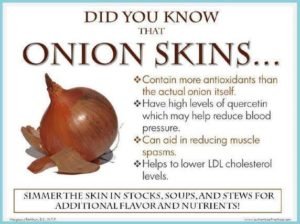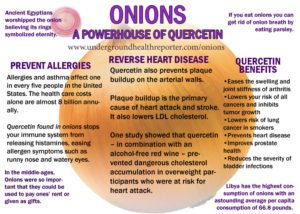 Let’s Think About Onions
Let’s Think About Onions
Different varieties of onions vary greatly in the amount of health-promoting benefits they deliver. Onions are a major source of two types of phytonutrients that protect against cardiovascular disease, cancer and asthma. The onions you choose and the way you prepare them make a huge difference in the amount of beneficial compounds, and antioxidant and anti-cancer effects you receive.
Generally, the more pungent onions give us more benefits. Of those available in the U.S., shallots have the most phenols, and Western Yellow onions have the most flavonoids, such as quercitin, noted for its asthma-protective effects. When tested against liver and colon cancer cells, Western Yellow, New York Bold and shallots were most effective in inhibiting their growth. Purple onions contain anthocyanins, the compounds found in cardio-protective purple grapes, berries and red wine.
Summer onions (such as Walla Walla, Vidalia and Maui Sweet Onions), have a higher sugar content and a lower phytonutrient content, so do not provide the same level of health-promoting properties.
Onionskins have powerful antioxidant and anti-inflammatory powers. They provide a rich source of flavenoids, including quercetin, a very powerful antioxidant and anti-inflammatory compound. It is being studied as an agent for lowering LDL cholesterol and blood pressure, fighting allergies, reducing inflammation, enhancing muscle growth and function, treating depression, some forms of cancer, and other conditions.
“Plants are the master chemists,” says Mary Ann Lila, who directs the Plants for Human Health Institute at North Carolina State University. “Because plants can’t move around, they have to manufacture what they need, not merely to grow, but to defend, protect, and heal themselves. It makes sense that the compounds plants produce in response to stress would help a human under similar circumstances.” It makes sense that plants would concentrate many of these protective compounds in the outer coverings—the skins and peels of various roots and fruits–the point where most environmental assaults would likely occur.
To extract quercetin and other beneficial plant compounds that onions skins might contain, toss a whole onion or two, scales and all, into the pot next time you make soup, put a stew into the crock pot, or cook rice. A nice side benefit: onion skins will impart a rich brown or deep mahogany color to your broth, depending on which color onion you use.
Ethnobotanist James Duke recommends an infusion of onionskins as a soothing wash for the itch of scabies and other skin disorders. Onionskins make gorgeous dyestuffs for natural fibers.
Do a lesson on onions for your classroom. Study that onion carefully. See if they can identify the different kinds that you have. Soak some skins and dye something.
I heard Tiny Tim sing the song “Onions, Onions, La La La” a long time ago, and it is such a catchy little tune and fun to sing. Kids would love learning it. Just put some onions in a bowl and see how many days till they start sprouting. Plant some chives outside and start a great little herb garden that will be a great teaching aid and pleasure to the senses!
Onion skins for health The outer skins of onions have powerful antioxidant and anti-inflammatory powers and provide an exceptionally rich source of plant compounds called flavenoids, especially the powerful antioxidant and anti-inflammatory compound, quercetin. Quercetin is under study as an agent for lowering LDL cholesterol and blood pressure, fighting allergies, reducing inflammation, enhancing muscle growth and function, treating depression, some forms of cancer, and other conditions.
“Plants are the master chemists,” says Mary Ann Lila, who directs the Plants for Human Health Institute at North Carolina State University. “Because plants can’t move around, they have to manufacture what they need, not merely to grow, but to defend, protect, and heal themselves. It makes sense that the compounds plants produce in response to stress would help a human under similar circumstances.” It makes sense that plants would concentrate many of these protective compounds in the outer coverings–skins and peels of various roots and fruits–the point where most environmental assaults would likely occur. To extract quercetin and other beneficial plant compounds that onions skins might contain, toss a whole onion or two, scales and all, into the pot next time you make soup, put a stew into the crock pot, or cook rice. A nice side benefit: onion skins will impart a rich brown or deep mahogany color to your broth, depending on which color onion you use.
Ethnobotanist James Duke recommends an infusion of onionskins as a soothing wash for the itch of scabies and other skin disorders. Onionskins make gorgeous dyestuffs for natural fibers.



